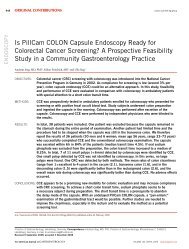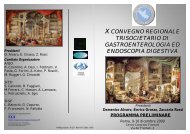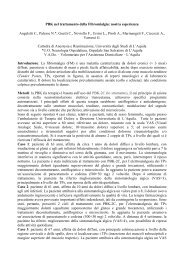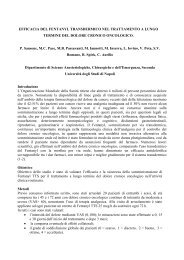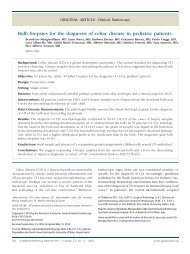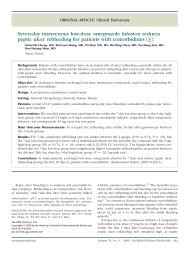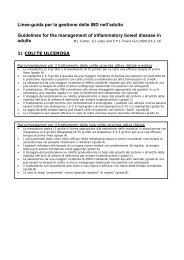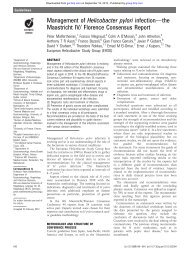The clinical utility of single-balloon enteroscopy: a single ... - TC Group
The clinical utility of single-balloon enteroscopy: a single ... - TC Group
The clinical utility of single-balloon enteroscopy: a single ... - TC Group
Create successful ePaper yourself
Turn your PDF publications into a flip-book with our unique Google optimized e-Paper software.
ORIGINAL ARTICLE: Clinical Endoscopy<br />
<strong>The</strong> <strong>clinical</strong> <strong>utility</strong> <strong>of</strong> <strong>single</strong>-<strong>balloon</strong> <strong>enteroscopy</strong>: a <strong>single</strong>-center<br />
experience <strong>of</strong> 172 procedures<br />
Bennie R. Upchurch, MD, Madhusudhan R. Sanaka, MD, Ana Rocio Lopez, MD, John J. Vargo, MD, MPH<br />
Cleveland, Ohio, USA<br />
Background: Single-<strong>balloon</strong> <strong>enteroscopy</strong> (SBE) is a novel endoscopic technique designed to evaluate and treat<br />
small-bowel disease. Although there is substantial literature addressing double-<strong>balloon</strong> <strong>enteroscopy</strong> and its<br />
impact on the diagnosis and management <strong>of</strong> small-bowel disease, there are limited data available on the <strong>clinical</strong><br />
<strong>utility</strong> <strong>of</strong> SBE.<br />
Objectives: To evaluate the <strong>clinical</strong> <strong>utility</strong> and diagnostic impact <strong>of</strong> SBE in a large cohort <strong>of</strong> patients at a <strong>single</strong><br />
tertiary center.<br />
Design: Single-center, retrospective study.<br />
Setting: Digestive Disease Institute, Cleveland Clinic, Cleveland, Ohio.<br />
Patients: A total <strong>of</strong> 161 patients were referred for SBE from January 2006 to August 2008.<br />
Main Outcome Measurements: Demographic, <strong>clinical</strong>, procedural, and outcome data were collected and<br />
analyzed.<br />
Results: A total <strong>of</strong> 161 patients underwent a total <strong>of</strong> 172 procedures. Antegrade and retrograde approaches were<br />
used in 83% and 17% <strong>of</strong> subjects, respectively. <strong>The</strong> average insertion depth using the antegrade approach was<br />
132 cm beyond the ligament <strong>of</strong> Treitz (range 20-400 cm). <strong>The</strong> average insertion depth using the retrograde<br />
approach was 73 cm above the ileocecal valve (range 10-160 cm). <strong>The</strong> average procedure time was 40 minutes<br />
overall, 38 minutes (range 12-90) antegrade and 48 minutes (range 28-89) retrograde. Fluoroscopy was used in<br />
20 cases (12%). Diagnostic yield was 58% (99/172); 42% (72/172) were therapeutic cases. <strong>The</strong>re were no<br />
significant complications.<br />
Limitations: Single-center, retrospective study.<br />
Conclusions: SBE demonstrated a high diagnostic yield and frequently provided useful therapeutic intervention. It<br />
seems to be a safe and effective method for performing deep <strong>enteroscopy</strong>. (Gastrointest Endosc 2010;71:1218-23.)<br />
Abbreviations: DBE, double-<strong>balloon</strong> <strong>enteroscopy</strong>; SBE, <strong>single</strong>-<strong>balloon</strong> <strong>enteroscopy</strong>.<br />
DISCLOSURE: All authors disclosed no financial relationships relevant to<br />
this publication.<br />
Copyright © 2010 by the American Society for Gastrointestinal Endoscopy<br />
0016-5107/$36.00<br />
doi:10.1016/j.gie.2010.01.012<br />
Received October 31, 2009. Accepted January 1, 2010.<br />
Until the advent <strong>of</strong> capsule endoscopy and <strong>balloon</strong>assisted<br />
<strong>enteroscopy</strong>, the nonsurgical management <strong>of</strong> suspected<br />
small-bowel disease had been limited. 1 Traditional<br />
approaches using conventional endoscopic techniques<br />
such as push <strong>enteroscopy</strong> and imaging techniques such as<br />
barium small-bowel series and enteroclysis have had low<br />
yield. Even more specialized studies such as intraoperative<br />
<strong>enteroscopy</strong>, diagnostic CT enterography, magnetic resonance<br />
angiography, and interventional angiography have<br />
all had substantially greater invasiveness, cost, and morbidity<br />
without a significantly increased yield. 2-5 Capsule<br />
endoscopy has provided the diagnostic capability to visualize<br />
the small bowel far beyond the aforementioned modalities,<br />
but <strong>of</strong>fers no therapeutic capability to date. <strong>The</strong><br />
superior diagnostic and therapeutic impact <strong>of</strong> double<strong>balloon</strong><br />
<strong>enteroscopy</strong> (DBE) has, along with capsule en-<br />
Current affiliations: Digestive Disease Institute (B.R.U., M.R.S., J.J.V.),<br />
Department <strong>of</strong> Quantitative Health Sciences (A.R.L.), Cleveland Clinic,<br />
Cleveland, Ohio, USA.<br />
Reprint requests: Bennie R. Upchurch, MD, Digestive Disease Institute,<br />
9500 Euclid Avenue, A31, Cleveland, OH 44195.<br />
1218 GASTROINTESTINAL ENDOSCOPY Volume 71, No. 7 : 2010 www.giejournal.org
Upchurch et al<br />
Clinical <strong>utility</strong> <strong>of</strong> <strong>single</strong>-<strong>balloon</strong> <strong>enteroscopy</strong><br />
doscopy, ushered in a new era in small-bowel endoscopy.<br />
Numerous studies attest to the <strong>clinical</strong> impact <strong>of</strong> DBE and<br />
capsule endoscopy. 6-14<br />
Limitations <strong>of</strong> DBE reported by some authors include a<br />
significant learning curve, increased expense, long procedure<br />
times, inability to use in patients with latex allergy,<br />
and the cumbersome nature <strong>of</strong> the procedure. <strong>The</strong> more<br />
recently developed <strong>single</strong>-<strong>balloon</strong> <strong>enteroscopy</strong> (SBE) system<br />
by Olympus (Olympus Inc, Tokyo, Japan) has been<br />
proposed to be more intuitive, to be easier to set up and<br />
use, to <strong>of</strong>fer more compatibility with existing endoscopy<br />
systems, and to <strong>of</strong>fer abilities similar to those <strong>of</strong> the<br />
double-<strong>balloon</strong> system to address small-bowel pathology.<br />
<strong>The</strong>re are limited data available on SBE, and there are no<br />
published direct comparison studies <strong>of</strong> the 2 platforms.<br />
<strong>The</strong> primary aim <strong>of</strong> this retrospective study was to evaluate<br />
the <strong>clinical</strong> <strong>utility</strong> <strong>of</strong> SBE in patients referred to our facility<br />
with suspected small-bowel pathology.<br />
PATIENTS AND METHODS<br />
Chart reviews were conducted on patients referred to<br />
our hospital for <strong>enteroscopy</strong> from January 2006 to August<br />
2008. Demographic, <strong>clinical</strong>, and procedural data; findings;<br />
and complications were collected. Limited outcome<br />
data were obtained because <strong>of</strong> the nature <strong>of</strong> the referral<br />
practice. All patients were required to provide informed<br />
consent. <strong>The</strong> study was approved by the Cleveland Clinic<br />
Institutional Review Board. Inclusion criteria specified<br />
were suspected small-bowel disease after negative EGD<br />
and colonoscopy and/or localization <strong>of</strong> small-bowel pathology<br />
by capsule endoscopy or other imaging studies.<br />
Exclusion criteria included known large esophageal varices,<br />
severe active Crohn’s disease, fresh surgical stoma,<br />
severe ulcerative esophagitis, medical instability, and inability<br />
to provide informed consent. All patients referred<br />
for <strong>enteroscopy</strong> during this period who met inclusion and<br />
exclusion criteria were included in the study.<br />
All procedures were performed by 1 <strong>of</strong> 4 experienced<br />
endoscopists who had previous experience with DBE<br />
and/or advanced therapeutic endoscopy training. Our<br />
analysis <strong>of</strong> this experience began with the first SBE at our<br />
institution. Office consultation or a history and physical<br />
examination with supporting laboratory studies were generally<br />
obtained before the procedure and assessed by the<br />
endoscopist to determine the appropriateness <strong>of</strong> <strong>enteroscopy</strong><br />
as the standard <strong>of</strong> care. Urine pregnancy tests were<br />
performed before the procedure in women <strong>of</strong> childbearing<br />
potential. All patients and their drivers were given<br />
standard discharge instructions and numbers to call to<br />
report any postprocedure problems or suspected<br />
complications.<br />
Antegrade procedures (per oral) for inpatients were<br />
performed after 2-L polyethylene glycol preparation. Outpatient<br />
antegrade procedures required no specific preparation<br />
except for continuing to receive nothing by mouth<br />
Take-home Message<br />
●<br />
Single-<strong>balloon</strong> <strong>enteroscopy</strong> seems to have <strong>clinical</strong> <strong>utility</strong><br />
similar to that <strong>of</strong> double-<strong>balloon</strong> <strong>enteroscopy</strong> in this large<br />
cohort <strong>of</strong> patients with small-bowel disease in a <strong>single</strong>center<br />
referral practice.<br />
for 8 hours. Retrograde procedures (per rectum) were<br />
performed after 4-L polyethylene glycol preparation in all<br />
patients. Patients were sedated with moderate sedation<br />
including meperidine, fentanyl, and midazolam or with<br />
monitored anesthesia using prop<strong>of</strong>ol by an anesthesia<br />
provider. Fluoroscopy was used in selected cases depending<br />
on the preference <strong>of</strong> the endoscopist, technical difficulty,<br />
and anatomic approach (antegrade vs retrograde).<br />
Total procedure time was defined as the period from the<br />
insertion to withdrawal <strong>of</strong> the enteroscope. Estimated<br />
maximal depth <strong>of</strong> insertion with the antegrade approach<br />
was defined as number <strong>of</strong> centimeters beyond the ligament<br />
<strong>of</strong> Treitz when no further advancement was possible.<br />
From the retrograde approach, this represented the number<br />
<strong>of</strong> centimeters passed into the small bowel beyond the<br />
ileocecal valve. Depth was measured in centimeters using<br />
the total number <strong>of</strong> 40-cm push and pull cycles on insertion,<br />
as defined by May et al 15,16 or by simply counting the<br />
amount <strong>of</strong> small bowel traversed on withdrawal in 5- or<br />
10-cm increments. At the point <strong>of</strong> maximal insertion, a<br />
tattoo could be placed using SPOT ink (GI Supply, Camp<br />
Hill, Pa). Total <strong>enteroscopy</strong> was defined as visualizing the<br />
entire small bowel when the tattoo left by the previous<br />
examination was reached in the subsequent examination<br />
initiated from the opposite insertion route or if the ileocecal<br />
valve was reached from the antegrade route. Enteroscopy<br />
failure was defined as an inability to pass beyond 60<br />
cm from the ligament <strong>of</strong> Treitz with the antegrade approach<br />
or 20 cm above the ileocecal valve with the retrograde<br />
approach, based on recognized typical limits <strong>of</strong><br />
push <strong>enteroscopy</strong> and colonoscopy with ileal intubation,<br />
respectively. 9,17-21 <strong>The</strong>rapeutic cases were defined as those<br />
that involved endoscopic intervention such as polypectomy,<br />
stricture dilation, foreign-body removal, and hemostasis<br />
procedures. Tissue sampling was performed as <strong>clinical</strong>ly<br />
appropriate.<br />
<strong>The</strong> decision to use an antegrade or retrograde initial<br />
approach was primarily determined by <strong>clinical</strong> presentation.<br />
If the patient presented with melena or if upper<br />
small-bowel pathology was suggested on imaging or capsule<br />
endoscopy, then an antegrade approach was used for<br />
the study. If the patient presented with frank hematochezia<br />
or if localization suggested a more distal small-bowel<br />
lesion, then the study was performed with the retrograde<br />
approach. <strong>The</strong> default approach was to use the antegrade<br />
approach for the examination if no <strong>clinical</strong> features were<br />
available to guide the decision, keeping in mind the con-<br />
www.giejournal.org Volume 71, No. 7 : 2010 GASTROINTESTINAL ENDOSCOPY 1219
Clinical <strong>utility</strong> <strong>of</strong> <strong>single</strong>-<strong>balloon</strong> <strong>enteroscopy</strong><br />
Upchurch et al<br />
Figure 1. Single-<strong>balloon</strong> enteroscope. (Courtesy <strong>of</strong> Olympus America<br />
Inc, Center Valley, Pa.)<br />
clusion <strong>of</strong> some authors in DBE that antegrade procedures<br />
may traverse twice the distance into the small bowel as<br />
that <strong>of</strong> retrograde examinations. 18-20,22-24 If pathology was<br />
not reached with the initial insertion route, a tattoo was<br />
placed and the opposite anatomic approach was performed,<br />
as deemed <strong>clinical</strong>ly appropriate.<br />
Single-<strong>balloon</strong> system<br />
<strong>The</strong> Olympus SIF–Q180 is a 200-cm high-resolution<br />
enteroscope with a 2.8-mm working channel that uses a<br />
140-cm long 13.2-mm outer diameter flexible overtube<br />
(Fig. 1). <strong>The</strong> silicone <strong>balloon</strong> at the tip <strong>of</strong> the overtube can<br />
be inflated and deflated by the <strong>balloon</strong> control module,<br />
with a pressure range <strong>of</strong> 6 to 16 kPa. This pressure allows<br />
atraumatic traction on the small-bowel mucosa. <strong>The</strong> tip <strong>of</strong><br />
the endoscope is angled and hooked behind a fold, if<br />
possible, to achieve the same stabilizing effect <strong>of</strong> the<br />
endoscope tip <strong>balloon</strong> <strong>of</strong> the double-<strong>balloon</strong> system.<br />
<strong>The</strong>n, in a very similar fashion to the double-<strong>balloon</strong><br />
technique, the overtube <strong>balloon</strong> is used to pleat the small<br />
bowel onto the overtube. With serial inflations and deflations<br />
<strong>of</strong> the overtube <strong>balloon</strong> and hooking and grasping<br />
with the endoscope tip, the endoscope is advanced deep<br />
into the small bowel with the push-and-pull technique. 23,25<br />
Ideally, as in DBE, the <strong>balloon</strong> is not inflated in the area <strong>of</strong><br />
the proximal duodenum to avoid trauma to the papilla and<br />
lessen the risk <strong>of</strong> pancreatitis. Early reports with this <strong>enteroscopy</strong><br />
system have shown favorable outcomes, both<br />
diagnostically and therapeutically, with similar <strong>utility</strong> to<br />
that <strong>of</strong> the double-<strong>balloon</strong> technique. 5,21-23,25-34<br />
Figure 2. Indication for SBE. Nonexclusive; patients with anemia included<br />
26% overt and 29% occult bleeding.<br />
Statistical analysis<br />
Data are presented as mean (range) for continuous<br />
variables and percentages for categorical factors. Student t<br />
test for continuous variables and the 2 and Fisher exact<br />
tests for categorical factors were used to compare the 2<br />
SBE approaches. P .05 was considered statistically significant.<br />
SAS version 9.2 s<strong>of</strong>tware (SAS Institute, Cary, NC)<br />
and R 2.9.1 (<strong>The</strong> R Foundation for Statistical Computing,<br />
Vienna, Austria) were used for all analyses.<br />
RESULTS<br />
A total <strong>of</strong> 172 procedures were performed in 161<br />
patients. <strong>The</strong>re were 83 women and 78 men studied.<br />
<strong>The</strong> mean age was 64 years, and the range was 23 to 88<br />
years. <strong>The</strong> most common indication was anemia, with<br />
59% (102/172) patients referred; 45% (46/102) <strong>of</strong> these<br />
patients had overt bleeding and 50% (51/102) had occult<br />
GI bleeding. In 4% (5/102) <strong>of</strong> the patients referred<br />
for anemia, the nature <strong>of</strong> the bleeding was undetermined.<br />
Six percent (11/172) <strong>of</strong> patients were referred<br />
for suspected inflammatory bowel disease, 4% (8/172)<br />
<strong>of</strong> patients were referred for abdominal pain, 4% (8/<br />
172) <strong>of</strong> patients were referred for a suspected smallbowel<br />
mass, and 2% (5/172) <strong>of</strong> patients were referred<br />
for chronic diarrhea (Fig. 2).<br />
We performed a total <strong>of</strong> 143 antegrade procedures<br />
and 29 retrograde procedures. Conscious sedation was<br />
used in 85% (146/172) <strong>of</strong> procedures. Prop<strong>of</strong>ol-based<br />
monitored anesthesia care was provided by an anesthesia<br />
team when indicated. <strong>The</strong> average depth <strong>of</strong> insertion<br />
from the antegrade approach was 133 cm beyond the<br />
ligament <strong>of</strong> Treitz (range 20-400 cm). <strong>The</strong> average depth<br />
<strong>of</strong> insertion from the retrograde approach was 73 cm<br />
above the ileocecal valve (range 10-160 cm). <strong>The</strong> average<br />
procedure time for an antegrade approach was 38<br />
minutes (range 12-90 minutes). <strong>The</strong> average procedure<br />
time for a retrograde procedure was 48 minutes (range<br />
24-89 minutes). Overall, the average procedure time<br />
was 40 minutes (standard deviation 17.1). Fluoroscopy<br />
was used in 20 (12%) cases, and the average time used<br />
1220 GASTROINTESTINAL ENDOSCOPY Volume 71, No. 7 : 2010 www.giejournal.org
Upchurch et al<br />
Clinical <strong>utility</strong> <strong>of</strong> <strong>single</strong>-<strong>balloon</strong> <strong>enteroscopy</strong><br />
TABLE 1. SBE Indications, procedural factors and findings.<br />
Factor<br />
All<br />
(n 172)<br />
Antegrade<br />
(n 143)<br />
Retrograde<br />
(n 29) P value<br />
Indication (nonexclusive)<br />
Anemia 102 (59.3) 86 (60.1) 16 (55.2) .62<br />
Overt bleeding 46 (26.7) 41 (28.7) 5 (17.2) .2<br />
Occult bleeding 50 (29.1) 38 (26.6) 12 (41.4) .11<br />
Suspected IBD 11 (6.4) 7 (4.9) 4 (13.8) .092<br />
Suspected mass 8 (4.7) 7 (4.9) 1 (3.5) .99<br />
Abdominal pain 8 (4.7) 6 (4.2) 2 (6.9) .62<br />
Diarrhea 5 (2.9) 3 (2.1) 2 (6.9) .2<br />
Procedure time (min) 40.2 (17.1) 38.2 (17.1) 47.7 (15.0) .008<br />
Insertion depth (cm) 121.9 (80.2) 132.8 (82.9) 73.3 (40.2) .001<br />
Fluoroscopy time (min) 4.1 (4.0) 3.7 (3.0) 4.6 (5.1) .67<br />
Conscious sedation 146 (84.9) 122 (85.3) 24 (82.8) .78<br />
Interventional BAE 77 (45.0) 68 (47.9) 9 (31.0) .097<br />
Any BAE finding* 106 (62.0) 87 (61.3) 19 (65.5) .67<br />
Findings* (nonexclusive)<br />
Angioectasia/telangiectasia 73 (42.7) 65 (45.8) 8 (27.6) .071<br />
Erosions 2 (1.2) 2 (1.4) 0 (0.0) .99<br />
Ulcers 8 (4.7) 5 (3.5) 3 (10.3) .14<br />
Strictures 3 (1.8) 1 (0.7) 2 (6.9) .075<br />
Polyps 10 (5.9) 6 (4.2) 4 (13.8) .068<br />
Blood in lumen 4 (2.3) 2 (1.4) 2 (6.9) .13<br />
Acid hematin 3 (1.8) 3 (2.1) 0 (0.0) .99<br />
Failure 18 (10.5) 15 (10.5) 3 (10.3) .99<br />
IBD, Inflammatory bowel disease; BAE, <strong>balloon</strong> assisted Enteroscopy.<br />
Values presented as mean (SD) for time and depth and no. (%) otherwise. P values correspond to Student t test for time and depth and Pearson’s 2 or the<br />
Fisher exact test otherwise.<br />
*1 subject with unknown finding.<br />
per case was 4 minutes (range 12 seconds to 14 minutes).<br />
<strong>The</strong> first 15 retrograde cases had an average<br />
insertion depth <strong>of</strong> 85 cm and an average procedure time<br />
<strong>of</strong> 46 minutes; in the 3 cases in which fluoroscopy was<br />
used, the fluoroscopy time was 3.6 minutes (range 1.2-<br />
8.2 minutes). <strong>The</strong> next 14 retrograde cases had an average<br />
insertion depth <strong>of</strong> 61 cm and average procedure<br />
time <strong>of</strong> 47 minutes; in the 4 cases in which fluoroscopy<br />
was used, the fluoroscopy time was 6.5 minutes (range<br />
32 seconds to 14 minutes) (Table 1).<br />
Findings<br />
<strong>The</strong> abnormalities detected at <strong>enteroscopy</strong> were angioectasia<br />
or telangiectasia in 73 (44%) procedures, 10 with<br />
polyps, 8 with ulcers, 6 with small-bowel diverticula, 4<br />
with blood in the lumen, 3 with acid hematin seen, 2 with<br />
strictures, and 2 with erosions. <strong>The</strong>re were normal findings<br />
(no pathology detected) in 65 procedures (37%). One<br />
subject had an unknown finding at <strong>enteroscopy</strong> (Table 1).<br />
Diagnostic yield<br />
Diagnostic yield was 58% (99/172), representing <strong>enteroscopy</strong><br />
findings deemed significant enough to explain<br />
symptoms or the source <strong>of</strong> bleeding. In the 7 cases in<br />
which acid hematin or blood in the lumen was found, but<br />
the source <strong>of</strong> bleeding not identified, we excluded these<br />
when determining our diagnostic yield. Forty-two percent<br />
(72/172) were therapeutic cases. Arteriovenous malforma-<br />
www.giejournal.org Volume 71, No. 7 : 2010 GASTROINTESTINAL ENDOSCOPY 1221
Clinical <strong>utility</strong> <strong>of</strong> <strong>single</strong>-<strong>balloon</strong> <strong>enteroscopy</strong><br />
Upchurch et al<br />
tions or telangiectasias were treated in 66 cases, 5 polyps<br />
were removed, and 1 stricture was dilated. <strong>The</strong> failure rate<br />
in the retrograde procedures was 10% (3/29) and 10%<br />
(15/149) in antegrade procedures. A total <strong>of</strong> 135 (78%)<br />
patients had capsule studies done before the <strong>enteroscopy</strong>.<br />
In 70 (40%) cases, the capsule findings were confirmed by<br />
the <strong>enteroscopy</strong>. A new diagnosis was found on <strong>enteroscopy</strong><br />
in 17.4% (30/172).<br />
Complications<br />
No serious complications occurred that were deemed<br />
related to the <strong>enteroscopy</strong>. One patient had a self-limited<br />
cardiac arrhythmia after the procedure. He had a history <strong>of</strong><br />
cardiac arrhythmias, and the event resolved spontaneously<br />
without the need for intervention. Another patient reported<br />
postprocedure abdominal pain that required an<br />
emergency department visit, without the need for<br />
intervention.<br />
DISCUSSION<br />
SBE has emerged as a viable alternative to DBE in the<br />
evaluation <strong>of</strong> small-bowel diseases. <strong>The</strong>re are limited data<br />
available to fully ascertain the exact role <strong>of</strong> the SBE system<br />
if DBE is available, and comparison studies are needed.<br />
This retrospective study <strong>of</strong> our initial experience with SBE<br />
demonstrates the abilities <strong>of</strong> the SBE system to provide a<br />
diagnostic yield similar to that <strong>of</strong> DBE, particularly in<br />
patients presenting with obscure GI bleeding. 5,21-23,25-37<br />
Attributes <strong>of</strong> SBE proposed by other investigators have<br />
included the ease <strong>of</strong> setup; the intuitive nature <strong>of</strong> the<br />
technique; shorter procedure time, perhaps with or without<br />
a corresponding decrease in the depth <strong>of</strong> insertion; a<br />
similar diagnostic yield; and potentially lower costs. 25,28-33<br />
In our experience, SBE demonstrated a yield <strong>of</strong> 58%,<br />
which compares favorably with that <strong>of</strong> published studies<br />
in both SBE and DBE. 5,21-39 Of 172 cases, 72 (42%) were<br />
therapeutic, primarily being the treatment <strong>of</strong> vascular lesions<br />
with argon plasma coagulation in 66 cases. <strong>The</strong><br />
concordance with capsule findings and <strong>enteroscopy</strong> findings<br />
was 40%, with vascular lesions having the highest<br />
correlation. Erosions on capsule studies correlated poorly<br />
with <strong>enteroscopy</strong> findings. Polypectomy was safely performed<br />
in the small bowel in 5 cases. In a patient with<br />
Crohn’s ileitis, an ileal stricture was dilated from the retrograde<br />
approach, after a failed attempt to reach the area<br />
with colonoscopy.<br />
Postprocedure abdominal pain has been reported in a<br />
small percentage <strong>of</strong> patients after SBE and DBE. Adhesions<br />
have been suggested to play a role in postprocedure pain<br />
by some. 38 <strong>The</strong> use <strong>of</strong> CO 2 for insufflation may reduce<br />
postprocedure pain, as suggested by some authors. 19,39<br />
This complication was not reported in our series for those<br />
individuals who did not report pain that persisted to or<br />
beyond the time that they met discharge parameters from<br />
endoscopy.<br />
<strong>The</strong> estimation <strong>of</strong> insertion depth has for some time<br />
been one <strong>of</strong> the more controversial aspects <strong>of</strong> the performance<br />
<strong>of</strong> <strong>balloon</strong>-assisted <strong>enteroscopy</strong>. Our initial approach<br />
was to count the centimeters <strong>of</strong> small bowel traversed<br />
on withdrawal. To move toward a more consistent<br />
standard and in preparation for an eventual comparison<br />
study, the trend was to record <strong>single</strong>-<strong>balloon</strong> insertion<br />
depth in the same 40-cm push-pull cycles as traditionally<br />
used for DBE. 16 Although this study does not serve as a<br />
comparison <strong>of</strong> SBE and DBE, some early observations can<br />
be made. <strong>The</strong> average procedure time for SBE was shorter<br />
than that for DBE. <strong>The</strong> insertion depth for SBE averaged<br />
less than that <strong>of</strong> DBE. Nevertheless, the overall yield for<br />
SBE did not differ greatly from that <strong>of</strong> published studies in<br />
DBE. 18,19,25,29,38 Although not quantitatively measured, the<br />
perceived setup time and ease <strong>of</strong> use <strong>of</strong> the SBE system<br />
were favored among our endoscopists and staff over that<br />
<strong>of</strong> the DBE.<br />
<strong>The</strong>re did not seem to be a significant learning curve<br />
with SBE for our group <strong>of</strong> endoscopists in terms <strong>of</strong> the<br />
technical difficulty <strong>of</strong> the procedure, reduction in fluoroscopy<br />
or procedure time, or insertion depth. It should be<br />
noted, however, that there were no total enteroscopies<br />
achieved in this early experience in patients with nonsurgically<br />
altered small bowel. In other reports <strong>of</strong> SBE in the<br />
West, the total <strong>enteroscopy</strong> rates also range from 0% to<br />
5%. 25,28,29 <strong>The</strong> vast majority <strong>of</strong> our cases were antegrade<br />
based on capsule findings, <strong>clinical</strong> presentation, or imaging,<br />
without total <strong>enteroscopy</strong> being intended. With good<br />
yield on the first procedure, most <strong>of</strong> these individuals who<br />
underwent antegrade procedures initially did not require<br />
retrograde procedures. Additionally, there was a very low<br />
failure rate (10%) in retrograde examinations in contrast to<br />
DBE. 18-20<br />
<strong>The</strong> limitations <strong>of</strong> this study include the <strong>single</strong>-center<br />
retrospective setting and the absence <strong>of</strong> long-term<br />
follow-up data. Larger prospective studies are needed to<br />
further assess the diagnostic and therapeutic potential <strong>of</strong><br />
the SBE system and its role relative to other modalities<br />
available for investigation <strong>of</strong> the small bowel.<br />
In conclusion, our early SBE experience represents the<br />
largest cohort <strong>of</strong> patients in a <strong>single</strong> center reported to<br />
date. It suggests that the SBE platform is safe and <strong>of</strong>fers a<br />
diagnostic and therapeutic yield in the management <strong>of</strong><br />
small-bowel disease similar to that <strong>of</strong> DBE.<br />
ACKNOWLEDGMENTS<br />
We thank Sabrina Vannoy, our nurse, who provided<br />
invaluable assistance with maintaining our database as<br />
well as superlative care <strong>of</strong> our <strong>enteroscopy</strong> patients.<br />
REFERENCES<br />
1. Lin S, Rockey D. Obscure gastrointestinal bleeding. Gastroenterol Clin<br />
North Am 2005;34:679-98.<br />
1222 GASTROINTESTINAL ENDOSCOPY Volume 71, No. 7 : 2010 www.giejournal.org
Upchurch et al<br />
Clinical <strong>utility</strong> <strong>of</strong> <strong>single</strong>-<strong>balloon</strong> <strong>enteroscopy</strong><br />
2. Raju G, Gerson L, Das A, et al. American Gastroenterological Association<br />
(AGA) Institute technical review on obscure gastrointestinal bleeding.<br />
Gastroenterology 2007;133:1697-717.<br />
3. Lewis B. Enteroscopy. Gastrointest Endosc Clin N Am 2000;10:101-16, vii.<br />
4. Mönkemüller K, Bellutti M, Malfertheiner P. Small–bowel endoscopy.<br />
Endoscopy 2007;39:978-85.<br />
5. Upchurch B, Vargo J. Small bowel <strong>enteroscopy</strong>. Rev Gastroenterol Disord<br />
2008;8:169-77.<br />
6. Lewis B. Obscure GI bleeding in the world <strong>of</strong> capsule endoscopy, push,<br />
and double <strong>balloon</strong> enteroscopies. Gastrointest Endosc 2007;66:S66-8.<br />
7. Lewis BS, Eisen GM, Friedman S. A pooled analysis to evaluate results <strong>of</strong><br />
capsule endoscopy trials. Endoscopy 2005;37:960-5.<br />
8. Triester S, Leighton J, Leontiadis G, et al. A meta-analysis <strong>of</strong> the yield <strong>of</strong><br />
capsule endoscopy compared to other diagnostic modalities in patients<br />
with non-stricturing small bowel Crohn’s disease. Am J Gastroenterol<br />
2006;101:954-64.<br />
9. Sidhu S, Sanders DS, Morris AJ. Guidelines on small bowel <strong>enteroscopy</strong><br />
and capsule endoscopy in adults. Gut 2008;57:125-36.<br />
10. Pasha S, Leighton J, Das A, et al. Double-<strong>balloon</strong> <strong>enteroscopy</strong> and capsule<br />
endoscopy have comparable diagnostic yield in small-bowel disease:<br />
a meta-analysis. Clin Gastroenterol Hepatol 2008;6:671-6.<br />
11. Hadithi M, Heine G, Jacobs M, et al. A prospective study comparing<br />
video capsule endoscopy with double-<strong>balloon</strong> <strong>enteroscopy</strong> in patients<br />
with obscure gastrointestinal bleeding. Am J Gastroenterol 2006;101:<br />
52-7.<br />
12. Matsumoto T, Esaki M, Moriyama T, et al. Comparison <strong>of</strong> capsule endoscopy<br />
and <strong>enteroscopy</strong> with the double-<strong>balloon</strong> method in patients with<br />
obscure bleeding and polyposis. Endoscopy 2005;37:827-32.<br />
13. Saurin JC, Delvaux M, Gaudin JL, et al. Diagnostic value <strong>of</strong> endoscopic<br />
capsule in patients with obscure digestive bleeding: blinded comparison<br />
with video push-<strong>enteroscopy</strong>. Endoscopy 2003;35:576-84.<br />
14. Pennazio M, Eisen G, Goldfarb N. ICCE consensus for obscure gastrointestinal<br />
bleeding. Endoscopy 2005;37:1046-50.<br />
15. May A, Nachbar L, Wardak A, et al. Double-<strong>balloon</strong> <strong>enteroscopy</strong>: preliminary<br />
experience in patients with obscure gastrointestinal bleeding or<br />
chronic abdominal pain. Endoscopy 2003;35:985-91.<br />
16. May A, Nachbar L, Schneider M, et al. Push-and-pull <strong>enteroscopy</strong> using<br />
the double-<strong>balloon</strong> technique method as assessing depth <strong>of</strong> insertion<br />
and training <strong>of</strong> the <strong>enteroscopy</strong> technique using the Erlangen endo<br />
Trainer. Endoscopy 2005;37:66-70.<br />
17. Heine GDN, Hadithi M, Groenen MJM, et al. Double–<strong>balloon</strong> <strong>enteroscopy</strong>:<br />
indications, diagnostic yield, and complications in a series <strong>of</strong> 275<br />
patients with suspected small–bowel disease. Endoscopy 2006;38:42-8.<br />
18. Mehdizadeh S, Ross A, Gerson L, et al. What is the learning curve associated<br />
with double-<strong>balloon</strong> <strong>enteroscopy</strong> Technical details and early experience<br />
in 6 U.S. tertiary care centers. Gastrointest Endosc 2006;64:740-<br />
50.<br />
19. Lo S. Technical matters in double <strong>balloon</strong> <strong>enteroscopy</strong>. Gastrointest Endosc<br />
2007;66:S15-8.<br />
20. Mehdizadeh S, Han N, Cheng D, et al. Success rate <strong>of</strong> retrograde double<strong>balloon</strong><br />
<strong>enteroscopy</strong>. Gastrointest Endosc 2007;65:633-9.<br />
21. May A, Nachbar L, Schneider M, et al. Prospective comparison <strong>of</strong> push<br />
<strong>enteroscopy</strong> and push-and-pull <strong>enteroscopy</strong> in patients with suspected<br />
small-bowel bleeding. Am J Gastroenterol 2006;101:2016-24.<br />
22. Pasha SF, Leighton JA, Das A, et al. Diagnostic yield and therapeutic<br />
<strong>utility</strong> <strong>of</strong> double-<strong>balloon</strong> <strong>enteroscopy</strong> (DBE) in patients with obscure<br />
gastrointestinal bleeding (OGIB): a systematic review [abstract]. Gastrointest<br />
Endosc 2007;65:AB366.<br />
23. May A, Ell C. Push-and-pull <strong>enteroscopy</strong> using the double-<strong>balloon</strong><br />
technique/double-<strong>balloon</strong> <strong>enteroscopy</strong>. Dig Liver Dis 2006;38:932-8.<br />
24. May A, Nachbar L. Endoscopic interventions in the small bowel using<br />
double <strong>balloon</strong> <strong>enteroscopy</strong>: feasibility and limitations. Am J Gastroenterol<br />
2007;102:527-35.<br />
25. Upchurch B, Vargo J. Single <strong>balloon</strong> <strong>enteroscopy</strong>. Gastrointest Endosc<br />
Clin N Am 2009;19:335-47.<br />
26. Yamamoto H, Kita H, Sunada K, et al. Clinical outcomes <strong>of</strong> double<strong>balloon</strong><br />
endoscopy for the diagnosis and treatment <strong>of</strong> small-intestinal<br />
diseases. Clin Gastroenterol Hepatol 2004;2:1010-6.<br />
27. May A. Current status <strong>of</strong> double <strong>balloon</strong> <strong>enteroscopy</strong> with focus on the<br />
Wiesbaden results. Gastrointest Endosc 2007;66:S12-4.<br />
28. Tsujikawa T, Saitoh Y, Andoh A, et al. Novel <strong>single</strong>-<strong>balloon</strong> <strong>enteroscopy</strong><br />
for diagnosis and treatment <strong>of</strong> the small intestine: preliminary experiences.<br />
Endoscopy 2008;40:11-5.<br />
29. Ramchandani M, Reddy D, Gupta R, et al. Diagnostic yield and therapeutic<br />
impact <strong>of</strong> <strong>single</strong>-<strong>balloon</strong> <strong>enteroscopy</strong>; series <strong>of</strong> 106 cases. J Gastroenterol<br />
Hepatol 2009;24:1631-8.<br />
30. Ohtsuka K, Kashida H, Kodama K. Diagnosis and treatment <strong>of</strong> small<br />
bowel diseases with a newly developed <strong>single</strong> <strong>balloon</strong> endoscope (new<br />
instrument and technique). Dig Endosc 2008;20:134-7.<br />
31. Mönkemüller K, Fry LC, Bellutti M, et al. Balloon-assisted <strong>enteroscopy</strong>;<br />
unifying double-<strong>balloon</strong> and <strong>single</strong> <strong>balloon</strong> <strong>enteroscopy</strong>. Endoscopy<br />
2008;40:537.<br />
32. Aktas H, Mensink P. <strong>The</strong>rapeutic <strong>balloon</strong>-assisted <strong>enteroscopy</strong>. Dig Dis<br />
2008;26:309-13.<br />
33. Madisch A, Schmolders J, Bruckner S, et al. Less favorable <strong>clinical</strong> outcome<br />
after diagnostic and interventional double <strong>balloon</strong> <strong>enteroscopy</strong><br />
in patients with suspected small-bowel bleeding Endoscopy 2008;40:<br />
731-4.<br />
34. Zhong J, Ma T, Zhang C, et al. A retrospective study <strong>of</strong> the application on<br />
double-<strong>balloon</strong> <strong>enteroscopy</strong> in 378 patients with suspected smallbowel<br />
diseases. Endoscopy 2007;39:208-15.<br />
35. Tanaka S, Mitsui K, Tatsuguchi A, et al. Current status <strong>of</strong> double <strong>balloon</strong><br />
endoscopy: indications, insertion route, sedation, complications, technical<br />
matters. Gastrointest Endosc 2007;66:S30-3.<br />
36. Mönkemüller K, Weigt J, Treiber G, et al. Diagnostic and therapeutic<br />
impact <strong>of</strong> double–<strong>balloon</strong> <strong>enteroscopy</strong>. Endoscopy 2006;38:67-72.<br />
37. Kita H, Yamamoto H, Yano T, et al. Double <strong>balloon</strong> endoscopy in two<br />
hundred fifty cases for the diagnosis and treatment <strong>of</strong> small intestinal<br />
disorders. Inflammapharmacology 2007;15:74-7.<br />
38. May A. Balloon <strong>enteroscopy</strong>: <strong>single</strong>-and-double-<strong>balloon</strong> <strong>enteroscopy</strong>.<br />
Gastrointest Clin N Am 2009;19:349-56.<br />
39. Domagk D, Bretthauer M, Lenz P, et al. Carbon dioxide insufflation improves<br />
intubation depth in double-<strong>balloon</strong> <strong>enteroscopy</strong>; a randomized,<br />
controlled, double-blind trial. Endoscopy 2007;39:1064-7.<br />
www.giejournal.org Volume 71, No. 7 : 2010 GASTROINTESTINAL ENDOSCOPY 1223



